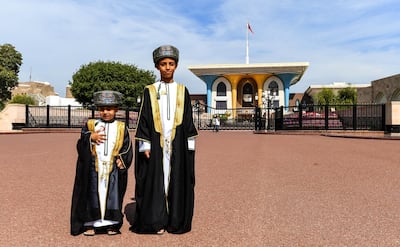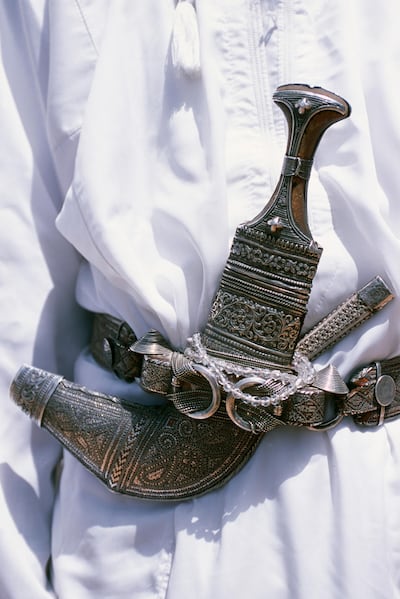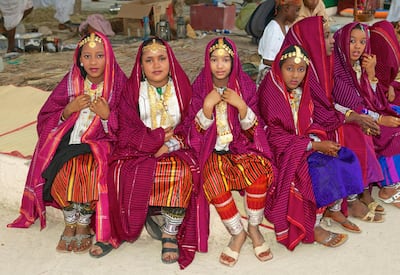Nestled between the Arabian Sea, Al Hajar Mountains and the Empty Quarter, Oman has a trading history that stretches back centuries. Once part of the Silk Route, which extended from China to Europe, the country forged its unique outlook over countless years spent trading beyond its borders, and this rich history is carried through to the present day via its national dress.
Drawing together three distinct influences, the clothes that Omani men and women wear combine elements from the Arabian world to the west, East Africa to the south, and India and Iran to the east.
Men wear a simple robe, the dishdasha, and an open-fronted outer layer on formal occasions, called a bisht, which is familiar across the UAE, Saudi Arabia and the rest of the Gulf.
Similar to the kandura of the UAE, the dishdasha is a floor length, long-sleeved garment that is worn collarless, and can come in any colour, including pale lilac and soft beige, with white usually reserved for the workplace. The overall cut in Oman tends to be looser and more roomy than its tailored UAE counterpart.
Subtle decorative stitching can be found around the neck (mahar) and the front opening, the shaq, while hanging from the neck is a detachable plaited tassel, called a farakha, which is often scented with traditional perfume. Although this feature appears on both Emirati and Omani national dress, in Oman it is worn much shorter.
A man's head can be covered with either a cap or a headscarf, while for those seeking a more structured look, both are worn at the same time. The cap is called a kuma and has its origins in East Africa. Called a kofia in Swahili, this high-sided hat is decorated with embroidered eyelets (called tanjeem) and is standard fare today in Omani wardrobes. However, this is a fairly recent development, as prior to the 1950s it implied a specific connection to East Africa and, in particular, the island of Zanzibar.
The woollen, embroidered head cloth that is worn either alone or over the cap, meanwhile, has very different origins. Called a massar, this finely-woven scarf is traditionally made with wool from Kashmir and is decorated with intricate hand embroidery. Much care is taken to match the headscarf with the dishdasha, and even more care goes into folding it to show off the needlework to full advantage.
A common design motif is the distinctive teardrop known in English as paisley, but locally referred to as boteh or buta. Hailing not from the Scottish town, it actually stems from the ancient Persian / Indian Zoroastrian religion. Said to be a symbol of the cypress tree, the shape is thought to represent life and eternity. Embroidered on fine wool, these Omani head scarves are wrapped in a squarish shape – often over the kuma – with overlapping folds in the front.
For ceremonial occasions, such as weddings, Eid and funerals, men will often wear a silver belt around the hips, or a shal, a wool scarf, that matches the colour and pattern of the massar. Worn tucked into this is the distinctive J-shaped Omani dagger called a khanjar. Now worn purely for show, the curved weapon has long been used as a marker of a family's wealth and status.
If Omani menswear is subtle, the women's dress is another matter entirely. Covered outside the home in the black abaya and shayla headscarf, underneath, the outfits are brightly coloured and richly decorated.
Women wear a short dress or tunic, over loose trousers, similar to the shalwar kameez that originated in Persia and Central Asia, and then spread across Afghanistan and the rest of the subcontinent. In Oman, the women traditionally wear a tunic called a dishdasha or kandura, that, like its subcontinental cousin hangs below the knee, though the exact length varies from region to region.
In the northern Omani region of Al Batinah, for example, it sits just below the knee, while in the Dhofar region of the south, the kandura reaches almost to the ankle in the front, and has a train at the back. Called abu thail, this style translates literally as dress with a tail.
Regardless of its location, the kandura is densely embroidered with metalwork that appears as wide cuffs on the sleeves and hem. A larger panel of work will cover the front, extending around the neck, and on some dresses, there is even a panel of handwork on the back.
In vivid contrast to the traditional gold or silver thread used for the embroidery, popular fabric choices for the kandura include those in lime green or orange, often with bold stripes. With Oman once part of the silk route, this penchant for stripes may well have been imported from Syria, courtesy of its coveted Damascene silks.
Worn underneath the dress are loose fitting trousers called sirwal, which taper into the ankle. These were not traditionally matched to the kandura, and instead gave women a chance to show their skill at pairing mismatched colours and patterns. Like the kandura, however, sirwal are also heavily embroidered, with gold or silver threads.
Today, synthetic threads are most commonly used, for cost and ease of handling (silver thread tarnishes) but traditionally, a woman's outfit was stitched with precious metals, so that in times of hardship, the fabric could be burnt and the wealth retrieved.
As a result, women's clothes were often extremely heavy, a tradition that lingered until very recently in wedding dresses across the GCC, which would have metal weights sewn into them in a nod to the not-so-distant past.

The patterning of the intricate metal embroidery itself can be traced back to zardozi work (from the words zar, gold, and dozi, embroidery, in Persian), which was introduced to India by the Mughals in the 16th century. From India, the motifs migrated across the sea to Oman, and their echoes can be seen in the decorations worn today. A fine headscarf called lissu or fattah is worn, and this has yet more metal embroidery around the border.
To finish their outfits, Omani women would have traditionally worn wooden platform shoes, but because of their cumbersome nature, these have largely been replaced by simple sandals.





